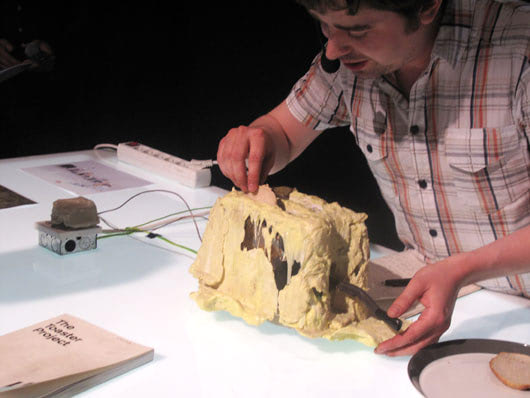Now here is an experiment any one can do at home: Look around in your house and try to find a consumer product of which you know where it was made and by whom. Got any? Indeed, this can be quite a difficult task nowadays. Which shows how disconnected we have become from the products surrounding us – for all we know they grow in the shopping tree.
Thomas Thwaites decided to take things in his own hand and see if he could build a toaster, from scratch - beginning by mining the raw materials and ending with a replica of a mass–produced toaster he bought in a shop for less than £5.00.
After some research Thomas determined that he needed only five materials to make a toaster.
"Copper, to make the pins of the electric plug, the cord, and internal wires. Iron to make the steel grilling apparatus, and the spring to pop up the toast. Nickel to make the heating element. Mica (a mineral a bit like slate) around which the heating element is wound, and of course plastic for the plug and cord insulation, and for the all important sleek looking casing. The first four of these materials are dug out of the ground, and plastic is derived from oil, which is generally sucked up through a hole."
In order to make his own plastic he needed raw oil. His first reflex was to contact British Petrol, but later he realized there is so much waste plastic floating around in our eco-system that he could just as well mine the plastic himself – some might consider this cheating, but they don't understand next nature.
After having mined some iron ore from an uneconomical mine in the UK, Thomas first tried to extract the metal using a chimney pot, some hair-dryers, a leaf blower, and a methodology from the 15th century. When he failed to get pure enough iron he decided become a bit more flexible and used a microwave to melt the iron (video).

The outcome of the project was a toaster that bears a somewhat imperfect likeness to the ones that we buy – a kind of half-baked, hand made pastiche of a consumer appliance.
The picture above shows Thomas first attempt to actually use his home-made toaster and make toast, during a Test lab event at V2_ in Rotterdam. Unfortunately for Thomas – hilarious for the audience though – the circuit in the toaster burned down immediately after it was switched on, resulting in the smell of toast, but not toast.
Clearly, baking your own toaster is not trivial. Yet one has to applaud Thomas for conducting such a wonderful informative project on how cheap, everyday items are dependent on amazingly complex and sophisticated global supply chains that are invisible and incomprehensible for consumers.


Comments (0)
Share your thoughts and join the technology debate!
No comments yet
Be the first to share your thoughts!